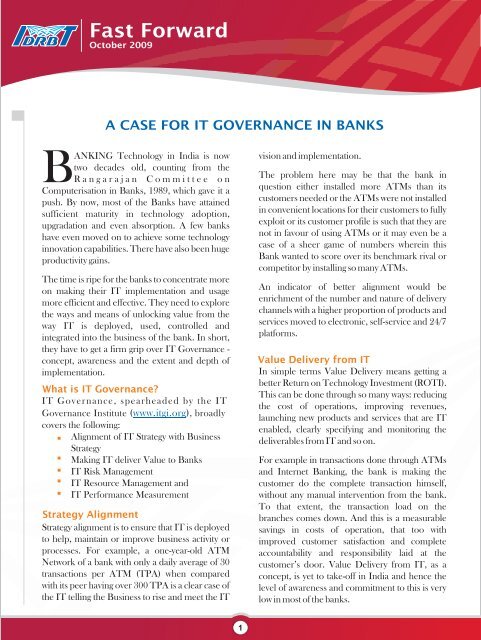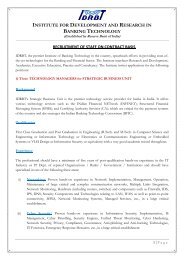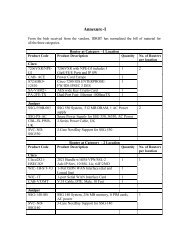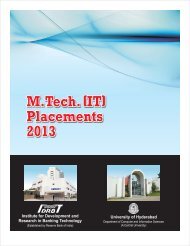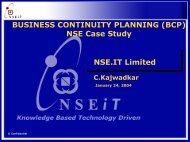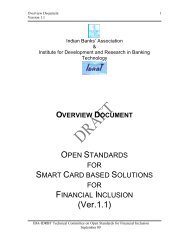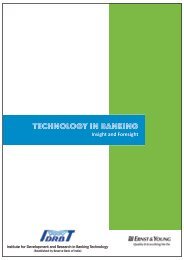Newsletter, October 2009 - IDRBT
Newsletter, October 2009 - IDRBT
Newsletter, October 2009 - IDRBT
You also want an ePaper? Increase the reach of your titles
YUMPU automatically turns print PDFs into web optimized ePapers that Google loves.
Fast Forward<br />
<strong>October</strong> <strong>2009</strong><br />
A CASE FOR IT GOVERNANCE IN BANKS<br />
ANKING Technology in India is now<br />
two decades old, counting from the<br />
BR a n g a r a j a n C o m m i t t e e o n<br />
Computerisation in Banks, 1989, which gave it a<br />
push. By now, most of the Banks have attained<br />
sufficient maturity in technology adoption,<br />
upgradation and even absorption. A few banks<br />
have even moved on to achieve some technology<br />
innovation capabilities. There have also been huge<br />
productivity gains.<br />
The time is ripe for the banks to concentrate more<br />
on making their IT implementation and usage<br />
more efficient and effective. They need to explore<br />
the ways and means of unlocking value from the<br />
way IT is deployed, used, controlled and<br />
integrated into the business of the bank. In short,<br />
they have to get a firm grip over IT Governance -<br />
concept, awareness and the extent and depth of<br />
implementation.<br />
What is IT Governance?<br />
IT Governance, spearheaded by the IT<br />
Governance Institute ( www.itgi.org), broadly<br />
covers the following:<br />
Alignment of IT Strategy with Business<br />
Strategy<br />
Making IT deliver Value to Banks<br />
IT Risk Management<br />
IT Resource Management and<br />
IT Performance Measurement<br />
Strategy Alignment<br />
Strategy alignment is to ensure that IT is deployed<br />
to help, maintain or improve business activity or<br />
processes. For example, a one-year-old ATM<br />
Network of a bank with only a daily average of 30<br />
transactions per ATM (TPA) when compared<br />
with its peer having over 300 TPA is a clear case of<br />
the IT telling the Business to rise and meet the IT<br />
vision and implementation.<br />
The problem here may be that the bank in<br />
question either installed more ATMs than its<br />
customers needed or the ATMs were not installed<br />
in convenient locations for their customers to fully<br />
exploit or its customer profile is such that they are<br />
not in favour of using ATMs or it may even be a<br />
case of a sheer game of numbers wherein this<br />
Bank wanted to score over its benchmark rival or<br />
competitor by installing so many ATMs.<br />
An indicator of better alignment would be<br />
enrichment of the number and nature of delivery<br />
channels with a higher proportion of products and<br />
services moved to electronic, self-service and 24/7<br />
platforms.<br />
Value Delivery from IT<br />
In simple terms Value Delivery means getting a<br />
better Return on Technology Investment (ROTI).<br />
This can be done through so many ways: reducing<br />
the cost of operations, improving revenues,<br />
launching new products and services that are IT<br />
enabled, clearly specifying and monitoring the<br />
deliverables from IT and so on.<br />
For example in transactions done through ATMs<br />
and Internet Banking, the bank is making the<br />
customer do the complete transaction himself,<br />
without any manual intervention from the bank.<br />
To that extent, the transaction load on the<br />
branches comes down. And this is a measurable<br />
savings in costs of operation, that too with<br />
improved customer satisfaction and complete<br />
accountability and responsibility laid at the<br />
customer’s door. Value Delivery from IT, as a<br />
concept, is yet to take-off in India and hence the<br />
level of awareness and commitment to this is very<br />
low in most of the banks.<br />
1


